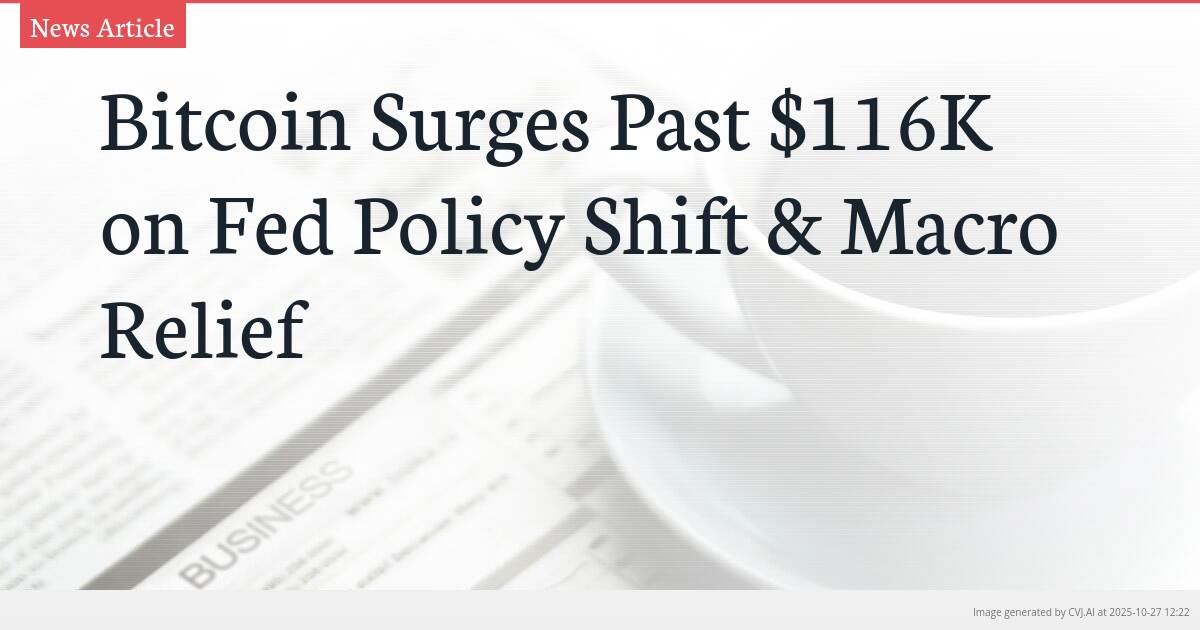This summary text is fully AI-generated and may therefore contain errors or be incomplete.
Introduction
Cryptocurrency markets opened the week with a powerful surge as Bitcoin breached $116,000, reaching its highest level in weeks. The rally was fueled by shifting macroeconomic conditions and easing Federal Reserve policy expectations. Ethereum, Solana, and other major altcoins joined the upward momentum, signaling broad market recovery from recent consolidation phases.
Key Points
- $365 million in short positions were liquidated during the rally, affecting over 100,000 traders
- Institutional buyers including ETFs and corporate treasuries absorbed sell-side supply to sustain upward momentum
- Negative funding rates and highly negative sentiment indicators preceded the sharp market reversal
Broad-Based Crypto Rally Gains Momentum
Digital asset markets experienced a synchronized uptrend this week, with Bitcoin climbing to a fresh intraday high above $116,000 before stabilizing near $115,587. This represents the cryptocurrency’s highest price level in weeks, bringing it within sight of its previous all-time high. The rally extended across major altcoins, with Ethereum pushing toward $4,200 and Solana breaking past the $200 psychological barrier.
The upward movement wasn’t limited to the largest cryptocurrencies. Other top digital assets including BNB, Cardano, Chainlink, and Hyperliquid registered significant gains during the reporting period. This broad-based advance signaled renewed momentum after several sessions of exhaustion and consolidation across major altcoins, suggesting institutional and retail interest returning to the sector simultaneously.
On-Chain Data Reveals Fundamental Shift
Critical on-chain indicators suggest the current rally extends beyond mere speculation. According to data from Glassnode, both spot and futures cumulative volume delta (CVD) have flattened for the first time since the October 10 sell-off. This technical development indicates that aggressive selling pressure has finally eased after nearly two weeks of market capitulation, creating conditions ripe for sustainable price appreciation.
Further supporting the organic nature of the move, funding rates remain below the neutral 0.01% threshold, indicating traders aren’t excessively leveraged to the upside. In fact, funding briefly dipped into negative territory multiple times over the past two weeks, reflecting a cautious market still recovering from its recent shakeout. Short-dated option skews also revealed that sentiment reached highly negative levels just before the uptrend began—a dynamic that often precedes sharp market reversals.
Macroeconomic Factors Drive Capital Rotation
According to Timothy Misir, head of research at BRN, macroeconomic headlines “did the heavy lifting” for Bitcoin’s current rise. He pointed to reports of progress toward a US-China trade framework and signs of a softer Federal Reserve stance as key drivers that narrowed risk premia and encouraged capital rotation into crypto assets. The resulting rally has become “highly headline-dependent,” where positive news triggers outsized squeezes while any policy backtrack could quickly unwind gains.
The rebound triggered widespread liquidations across derivatives markets, with data from Coinglass showing approximately $365 million in short positions wiped out within hours, affecting over 100,000 traders. Bitcoin shorts alone accounted for nearly $174 million of those losses. Misir noted that this combination of macro easing and forced short covering created what he described as a “short, sharp risk-on leg” in cryptocurrency markets.
Institutional buyers played a crucial role in sustaining the upward momentum, with ETFs, corporate treasuries, and mid-sized whales absorbing sell-side supply. However, Misir cautioned that the market structure remains fragile, with options and futures positioning leaving the front end vulnerable to headline volatility. He advised traders to “treat any break above $116,000 as a potential liquidity magnet (and any failure below $108,500 as a tactical sell signal)” given the current market sensitivity to macroeconomic developments.
📎 Read the original article on cryptoslate.com

